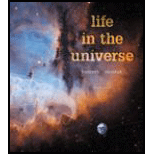
Concept explainers
Making a Living. Consider various methods by which life “makes a living” (the ways in which it acquires energy for
Want to see the full answer?
Check out a sample textbook solution
Chapter 7 Solutions
Life in the Universe (4th Edition)
Additional Science Textbook Solutions
Modern Physics
An Introduction to Thermal Physics
University Physics with Modern Physics (14th Edition)
College Physics (10th Edition)
Physics: Principles with Applications
Physics for Scientists and Engineers: A Strategic Approach, Vol. 1 (Chs 1-21) (4th Edition)
- What are the advantages to using radio waves for communication between civilizations that live around different stars? List as many as you can.arrow_forwardWhich of the following seems least reasonable regarding life on Earth? Group of answer choices There is much scientific evidence suggesting that all creatures living on Earth today appear to have evolved from a common ancestor. Louis Pasteur discredited the concept of spontaneous generation by demonstrating that even bacteria and other microorganisms arise from parents resembling themselves. There is ample physical evidence that the earliest life forms on Earth were multicellular creatures, perhaps resembling some of our primitive fish. When the earth formed some 4.6 billion years ago, it was a lifeless, inhospitable place. Before the mid-17th century, most people believed that God had created humankind and other higher organisms and that insects, frogs, and other small creatures could arise spontaneously in mud or decaying matter About billion years into its development, the Earth it was teeming with organisms resembling blue-green algae.arrow_forwardTutorial A radio broadcast left Earth in 1925. How far in light years has it traveled? If there is, on average, 1 star system per 400 cubic light years, how many star systems has this broadcast reached? Assume that the fraction of these star systems that have planets is 0.30 and that, in a given planetary system, the average number of planets that have orbited in the habitable zone for 4 billion years is 0.85. How many possible planets with life could have heard this signal? Part 1 of 3 To figure out how many light years a signal has traveled we need to know how long since the signal left Earth. If the signal left in 1925, distance in light years = time since broadcast left Earth. d = tnow - tbroadcast d = light years Submit Skip (you cannot come back)arrow_forward
- Imagine that we discovered a new planet that has the potential to support life. This planet has plenty of water on its surface and carbon dioxide in its atmosphere, and a nice, comfortable temperature similar to Earth. The only difference is that this planet orbits a star that produces green light only. If we took some plants from Earth and planted them on this new planet, would our plants be able to grow? Explain your answer.arrow_forwardWhich of the following is least reasonable regarding the difficulty in contacting extraterrestrial life using space flight and radio communication. Group of answer choices Space flight to the nearest star would take thousands of years with current technology. Even if another intelligent civilization is within a few hundred light-years of us, conversations would be very slow with a turnaround time of decades or even centuries. The spacecraft that NASA sent to Proxima Centauri a few years ago should be approaching its target within a decade or two, depending on solar wind conditions. Earth has been broadcasting at radio wavelengths since the 1930's, so any civilization within a radius of about 100 light-years or so could have received the broadcast by now. Without some major breakthrough, interstellar space flight is totally impractical.arrow_forwardHow can we apply the principles of Charles Darwin's theory of evolution by natural selection in our everyday life?arrow_forward
- A radio broadcast left Earth in 1911. How far in light years has it traveled? If there is, on average, 1 star system per 400 cubic light years, how many star systems has this broadcast reached? Assume that the fraction of these star systems that have planets is 0.50 and that, in a given planetary system, the average number of planets that have orbited in the habitable zone for 4 billion years is 0.20. How many possible planets with life could have heard this signal?arrow_forwardIf we do find life on Mars, what might be some ways to check whether it formed separately from Earth life, or whether exchanges of material between the two planets meant that the two forms of life have a common origin?arrow_forwardWhat is the difference between chemical evolution and biological evolution?arrow_forward
- What are two characteristic properties of life that distinguish it from nonliving things?arrow_forwardWhy was the development of photosynthesis a major milestone in the evolution of life?arrow_forwardWhat are the three requirements that scientists believe an environment needs to supply life with in order to be considered habitable?arrow_forward
 AstronomyPhysicsISBN:9781938168284Author:Andrew Fraknoi; David Morrison; Sidney C. WolffPublisher:OpenStax
AstronomyPhysicsISBN:9781938168284Author:Andrew Fraknoi; David Morrison; Sidney C. WolffPublisher:OpenStax
 Stars and Galaxies (MindTap Course List)PhysicsISBN:9781337399944Author:Michael A. SeedsPublisher:Cengage Learning
Stars and Galaxies (MindTap Course List)PhysicsISBN:9781337399944Author:Michael A. SeedsPublisher:Cengage Learning Foundations of Astronomy (MindTap Course List)PhysicsISBN:9781337399920Author:Michael A. Seeds, Dana BackmanPublisher:Cengage Learning
Foundations of Astronomy (MindTap Course List)PhysicsISBN:9781337399920Author:Michael A. Seeds, Dana BackmanPublisher:Cengage Learning
 Horizons: Exploring the Universe (MindTap Course ...PhysicsISBN:9781305960961Author:Michael A. Seeds, Dana BackmanPublisher:Cengage Learning
Horizons: Exploring the Universe (MindTap Course ...PhysicsISBN:9781305960961Author:Michael A. Seeds, Dana BackmanPublisher:Cengage Learning





